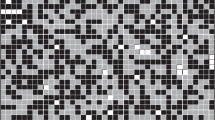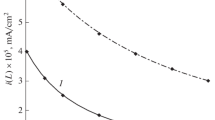Abstract
Currently, the development of lithium–oxygen (air) battery became a hot topic. It is recognised that its specific energy will exceed that of traditional lithium-ion batteries by order of magnitude. The principal element of the lithium–oxygen battery, that is, the active layer of the cathode constitutes a layer of material with a complicated pore structure. During discharge, some electrochemical and chemical processes therein result in the accumulation of lithium peroxide that eventually has been used in the lithium–oxygen battery charging. This power source still suffers from disadvantages, indeed. In this work, computer simulation is used in the elucidating of the effects of the cathode active layer structure on the lithium–oxygen battery overall characteristics during its charging and discharging. A set of obstacles on the way to improvement of the lithium–oxygen battery overall characteristics has been revealed. The obstacles are shown being crucial, they cannot be overcome in terms of current practice of the designing of the lithium–oxygen battery cathode. Therefore, new approaches to the manufacturing of lithium–oxygen battery cathode have to be sought for.





Similar content being viewed by others
REFERENCES
Christensen, J., A critical review of Li/air batteries, Christensen, J., Ed., J. Electrochem. Soc., 2012, vol. 159(2), p. R1.
Luntz, A.C., Nonaqueous Li–air batteries: a status report, Luntz, A.C. and McCloskey, B.D. Eds., Chem. Rev., 2014, vol. 114(23), p. 11721.
Nobuyki, I., The Lithium Air Battery: Fundamentals, Imanishi, N., Ed., Berlin: Springer, 2014.
Tran, C., Yang, X.-Q., and Qu, D., Investigation of the gas-diffusion-electrode used as lithium/air cathode in non-aqueous electrolyte and the importance of carbon material porosity, J. Power Sources, 2010, vol. 195(7), p. 2057.
Yang, X.-h., He, P., and Xia, Y.-y., Preparation of mesocellular carbon foam and its application for Lithium/Air Battery, Electrochem. Commun., 2009, vol. 11(6), p. 1127.
Laoire, C.O., Mukerjee, S., Abraham, K.M., Plichta E.J., and Hendrickson, M.A., Elucidating the mechanism of oxygen reduction for lithium–air battery applications, J. Phys. Chem. C, 2009, vol. 113(46), p. 20127.
Laoire, C.O., Influence of nonaqueous solvents on the electrochemistry of oxygen in the rechargeable lithium-air, J. Phys. Chem. C, 2010, vol. 114(19), p. 9178.
Ma, Z., Yuan, X., Li, L., Ma, Z-F., Wilkinson, D.P., Zhang, L., and Zhang, J., A review of cathode materials and structures for rechargeable lithium–air batteries, Energy Environ. Sci., 2015, vol. 8, p. 2144.
Tarasevich, M.R., Andreev, V.N., Korchagin, O.V., and Tripachev, O.V., Lithium–Oxygen (Air) Batteries (State-of-the-Art and Perspectives), Prot. Metals Phys. Chem. Surf. 2017, vol. 53(1), p. 3.
Bao, J., Hu, W., Bhattacharya, P., Stewart, M., Zhang, J.-G., and Pan, W., Discharge performance of Li–O2 batteries using a multiscale modeling approach, J. Phys. Chem. C., 2015, vol. 119(27), p. 14851.
Pan, W., Yang, X., Bao, J., and Wang, M., Optimizing discharge capacity of Li–O2 Batteries dy design of air-electrode porous structure: Multifidelity modeling and optimization, J. Electrochem. Soc., 2017, vol. 164(11), p. E3499.
Bogdanovskaya, V.A., Andreev, V.N., Chirkov, Yu.G., Rostokin, V.I., Emets, V.V., Korchagin, O.V., and Tripachev, O.V., Effect of the positive electrode structure on the discharging of lithium-oxygen (air) batteries. Theory of monoporous cathode, Prot. Metals Phys. Chem. Surf., 2018, no. 6, p. 549.
Chirkov, Yu.G., Andreev, V.N., Rostokin, V.I., and Bogdanovskaya, V.A., discharge of lithium-oxygen power source. Theory of monoporous cathode, the role of rate constant of oxygen flow (in Russian), Al’ternativnaya energetika, ekologia, 2018, nos. 4–6, p. 95.
Tarasevich,Yu.Yu., Percolation: theory, applications, algorithms (in Russian), Moscow: Editorial URSS, 2011.
Chirkov, Yu.G., Theory of porous electrodes. Percolation: calculations of the percolation lines, Russ. J. Electrochem., 1999, vol. 35, p. 1281.
Chirkov, Yu.G., Rostokin, V.I., and Skundin, A.M., Computer modeling of the positive electrode performance in lithium-ion batteries: model of equisized grains, percolation calculations, Russ. J. Electrochem., 2011, vol. 47, p. 71.
Zhang, G.Q., Zheng, J.P., Liang, R., Zhang, C., Wang, B., Hendrickson, M., and Plichta, E.J., Lithium–Air Batteries Using SWNT/CNF Buckypapers as Air Electrodes, J. Electrochem. Soc., 2010, vol. 157, p. A953.
Kirkpatrick, S., Percolation and Conduction, Rev. Mod. Phys., 1973, vol. 45, p. 574.
Stauffer, D., Scaling theory of percolation clusters, Phys. Reports, 1979, vol. 54, p. 1.
Funding
This work is supported by the Ministry of Sciences and Education RF.
Author information
Authors and Affiliations
Corresponding authors
Ethics declarations
The authors declare that they have no conflict of interest.
Additional information
Translated by Yu. Pleskov
The Calculations of Conductivity in a Three-Component Model
The Calculations of Conductivity in a Three-Component Model
The computer calculation of the effective reduced conductivity σ* of a three-component model cube containing two conducting components was carried out as follows. In the beginning, we simulated a cube containing 40 × 40 × 40 cells (“microcubes”) whose centers’ coordinates were fixed. The cells were randomly defined as carbonaceous (in proportion to the given concentration ω) and oxygen ones (with zero conductivity). Then, percolation clusters were formed, namely, the ionic cluster constituted with conducting cells-cubes (carbon grains) and the oxygen cluster comprising the cells filled with electrolyte with oxygen dissolved therein. The clusters connect the model-cube opposite faces (the frontal face and the rear one).
After the determining of the interphase contacts, the ionic cluster is considered being an aggregate of two conducting components: the type 1 cells with the conductivity σ1 = 1 and the type 2 cells with a preset conductivity σ2 < σ1.
Each conducting cell was represented with equivalent electrical elements of six links with a common node located in the cell center. Eventually, we obtained a lattice of nodes with random distribution of conducting links. Naturally, we assumed that the carbon cell conductivity is the same both in vertical and horizontal directions.
We used the Monte-Carlo method [18, 19] in the determining of the conductivity of the three-dimensional lattice of the conducting cells. Real “meat” of the method is as follows. The nodes of the lattice are numbered with integer numbers. Each constitutional unit connecting ith and kth nodes has conductivity of σi,k = (2σiσk)/(σi + σk). In particular, when a constitutional unit connects centers of neighboring type 1 active cells we have σi,k = σ1; when it connects centers of the type 2 cubes, σi, k = σ2. The conductivity between the different-type grain centers is σi, k = (2σ1σ2)/(σ1 + σ2).
According to the Ohm’s law, the current in a separated grain is:
where Ui is the electrical potential in the ith node.
Local currents are described by the Kirchhoff equation (the sum of the currents convergent in each node is zero):
where the summation is over all neighboring nodes with which the ith node is connected via the constitutional units. It follows from the Kirchhoff equation that the potentials of neighboring nodes are interrelated as follows:
provided the currents are steady-state. We set the value of the potential Ui in each node of the frontal layer of links equal to one; in the nodes of the opposite (rear) layer of links, the potential has been zeroed (the potentials remain unchanged in the course of numerical iterations). The potentials of inner nodes Ui at the start of the calculations are assigned arbitrarily in the 0–1 range.
Starting with this point, we calculated the potential for each node by solving equation (А.3) numerically. The nodes are treated sequentially, layer by layer, away from the model cube frontal surface toward its rear side.
After the first run over all nodes, the potentials can be redistributed significantly. However, in the subsequent iterations the potential distribution eventually becomes steady state. The iterations are stopped when the value of the current at the cube frontal side IF appears nearly equal to that at the rear side IR.
The current at the cube’s frontal side is sought for as the sum of currents passing from the node with the potential U = 1 toward the nearest nodes in the adjacent layer:
Similarly, the current at the rear side is determined by the equality:
where the summation is carried out over all the nodes contacting the rear side with the potential U = 0; the number of the rear layer is N = 40.
The effective conductivity of each particular configuration of the model lattice is determined as the ratio of the current in the system and the potential difference at the cube’s external boundaries: keff = I/ΔU = 1, because we assumed that ΔU = (UF – UR) = 1. The average effective conductivity was calculated by the averaging of the quantity keff in n = 1000 by random distribution of the carbon and oxygen cells in the model cube.
Rights and permissions
About this article
Cite this article
Chirkov, Y.G., Rostokin, V.I., Andreev, V.N. et al. Computer Simulation of the Structure and Operation Mechanisms for the Active Layer of Lithium–Oxygen Battery Cathode. Russ J Electrochem 56, 230–238 (2020). https://doi.org/10.1134/S1023193520030027
Received:
Revised:
Accepted:
Published:
Issue Date:
DOI: https://doi.org/10.1134/S1023193520030027




